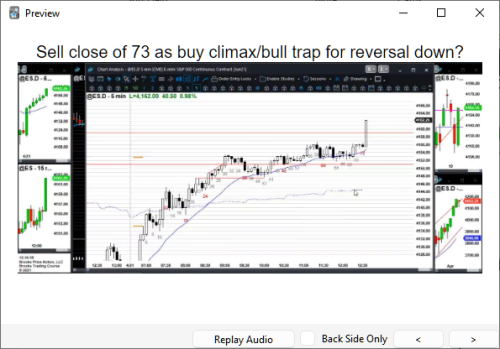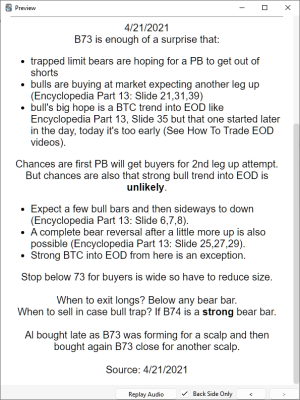The support forum is built with (1) General and FAQ forums for common trading queries received from aspiring and experienced traders, and (2) forums for course video topics. How to Trade Price Action and How to Trade Forex Price Action videos are consolidated into common forums.
Brooks Trading Course social media communities
What resources do you study with? BTC, Trading room recordings, encyclopaedia, daily setups,...?
And how do you study them?
I generate flash cards and quizzes. I also go into a replay simulator and look for setups I just learned about. I hand write my notes because research shows that hand writing things helps much more with memory than typing out things.
My main ones are Anki flashcards from watching historic webinars and sim replays on weekends (Ninjatrader has an excellent simulator where one can change the speed and place trades like in live).
HOW I STUDY, in order of my current preference
1a) Trade live, but if experimenting then trade demo.
1b) Use selected screen grabs for a topic and subtopics from the encyclopedia; review those selected slides periodically.
2a) Take a blank chart, add red and green boxes and compare to AL's. Then try to figure out why I missed some, or why I chose some that Al did not.
2b) Something I did in the past and recently did with the two BONUS videos 15-16: Take screen shots of the LAST SLIDES in each video; then study those slides. (And by the way, these were excellent and while covered in the encyclopedia, these ones made ii, ioi, OO trading SO much more clear).
3a) In the past I would look at "FORUM bar by bar" and try to guess the next bar. Then look at ALs explanation. But this has often been more confusing than helpful because AL usually says both "yes" and "no". Also the lines for the future are already drawn, so you know where it is going to turn around.
3b) Using NT8 sim sometimes. But I think it does not give the proper feel compared to live action.
Watch Al's videos or read the BTC Encyclopedia on my Kindle while running on the treadmill. Every morning.
Hi, what does the BTC Encyclopedia add to the course please ?
Hi, what does the BTC Encyclopedia add to the course please ?
Hi Erwann,
The Encyclopedia contains thousands of examples of potential outcomes of days, grouped by BPA categories. You don't necessarily need it before completing the course. It's supplemental and is often used by traders while trading to get an idea of what to expect.
Still working on my study routine. I'm trying to figure out how to get a routine that is adapted to family and office free times.
Thought I'd chime in with my study approach:
I'm still working through the videos - almost done with them - so I try to watch 1-2 per day. As I do, I add notes to Evernote notebooks that correspond to the modules. I take notes on Al's dialog vs. slide notations, since the former is so much more detailed. I also include screenshots of most slides, and tag each note. The tagging allows me to zoom in quickly during a trade session, if needed.
I am subscribed to the encyclopedia, and use that regularly.
I have the Trading Range book, but have yet to really dig into it. I want to get through the videos first ad than will apply that time to the books.
I summarize each trade session chart in detail, and the next day compare my notes to the EOD summary.
I also try to look at at least 5 five-min charts per weekday, and more on the weekends. I started by going back 100 days, and have just worked my way forward. As I do, I capture as much as I can in terms of major patterns, and sometimes will find the corresponding EOD summary on the blog to compare notes.
In conjunction with this, I built a website that allows me to upload and tag chart screenshots. It essentially functions as my own encyclopedia, and this effort has been helpful in cementing a lot of lessons learned along the way. I can apply notes to each chart and when I call them up using a tag, those notes (and lessons) are all summarized.
My next plan with the website is an index card type approach to pattern guidelines - MTR, Small PB trends, etc. It's not a lot of work or time for me to create the functionality, and the repetition (as I discovered using the encyclopedia) is effective for me.
I've recently begun checking out Anki. Would you have an example of how you are creating flashcards for your study routine?
The front of the card is a screenshot and question extrapolated from something insightful that Al said during a webinar.
The back (answer) are notes based on Al's further comments about it and any additional metadata or references to my other notes elsewhere for more information.
It's important to not share publicly these Anki decks since they contain screenshots of Al's copyrighted materials. If wanting to share later it's better to insert your own chart screenshots since it's basically the same thing and not copyrighted.
Hope that helped!
CH
_________________________
Join BPA Telegram Group for any Anki questions.
Thanks that example was extremely helpful. I don't plan to share them. Was just thinking about about the best way to structure them.


